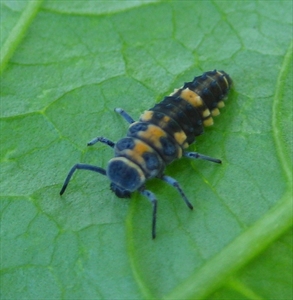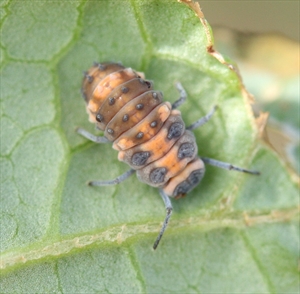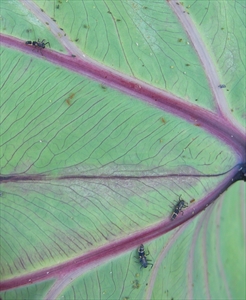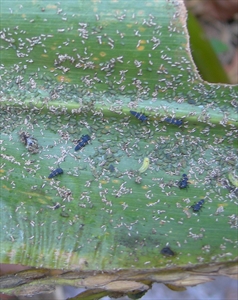Ladybeetles, ladybird beetles
Pacific Pests, Pathogens, Weeds & Pesticides - Online edition
Pacific Pests, Pathogens, Weeds & Pesticides
Predatory ladybeetles (083)
Phrynocaria sp; there are many others.
Lady beetle species of many different types are present worldwide, and occur in all Pacific island countries.
Aphids, mealybugs, scale insects, caterpillar eggs, mites.
Eggs are generally yellow and the shape of rice grains; they are laid on their ends in clusters, close to aphid colonies. The larvae hatch at the same time; they look like miniature crocodiles (Photos 1-4). They have spots or patches of dark blue, with areas of red or yellow. After several weeks of feeding the larva attaches to a leaf or a branch, and turns into a pupa. The pupa looks like a curled up larva, with similar colours. About a week later, the pupa splits and the adult crawls out. As the skin starts to dry and harden, the adult becomes characteristically yellowish-orange with black markings (Photo 5).
The larger species, feeding on aphids and insect eggs, are bluish-black and red or yellow; the smaller species, feeding on scale insects, are white with long waxy threads.
Ladybeetles do not damage crops: they are not pests. Predatory ladybeetles are beneficial; they occur on many crops, feeding on aphids, mealybugs, scales and other damaging insect pests.
It is important to distinguish predatory or 'farmer-friendly' ladybeetles from the plant-feeding ladybeetles belonging to the subfamily Epilachninae (see Fact Sheet no. 58). The adult plant-feeding ladybeetles have short soft hairs on the upper surface, and the larvae have long stiff spines over the body.
Look for adult ladybeetles with bright shiny, round bodies, which are red or orange with black markings or spots, without soft short hairs; look for the eggs, which are creamy yellowish-orange, laid in clusters close to aphid colonies; and look for the larvae, which are long, active, dark with yellow or red spots and patches, and covered in branched spines.
GENERAL
Ladybeetles are effective biological control agents, but will only appear in the crop if there is food for them, such as aphids or scales. Pesticides easily kill them, and routine spray programs will destroy any ladybeetles feeding on insect pests and mites.
MOVING THEM AROUND
As all stages of ladybeetles are relatively large, it is easy to move them to where they would do most good. Handpick adults and larvae, and pluck leaves with eggs and pupae and place them in a collecting (jam) jar. Transfer the contents of the jar onto the crop plants infested with pest species.
PROVIDING THEM WITH FOOD
Garden flowers and weeds provide ladybeetles with sugar from their nectar or pollen. Growing flowering plants in the field and around the edges will encourage ladybeetles to stay in the fields to breed. Basil and marigolds are useful garden flowers. Sonchus (sow thistles) and Chenapodium (goosefoots) are weeds that are particularly good sources of food for ladybeetles, providing nectar and pollen as well as aphids.
DANGERS FROM USING PESTICIDES
Pesticides are harmful to ladybeetles and should only be considered for control of aphids and other pests if ladybeetles are absent or in low numbers. If pesticides are needed, use ones that stay active on plant surfaces for a few days only. For example, use derris, pyrethrum, or synthetic pyrethroids. These are destroyed rapidly by sunlight.
AUTHORS Suzanne Neave & Grahame Jackson
Information from Hoffmann MP, Frodsham AC (1993) Lady Beetles. Natural enemies of vegetable insect pests. Cooperative Extension, Cornell University, Ithaca, NY. (https://biocontrol.entomology.cornell.edu/predators/ladybeetles.php); and Coccinellidae. Wikipedia. (https://en.wikipedia.org/wiki/Coccinellidae); and Bessin R (2019) Ladybugs. Cooperative Extension Service. University of Kentucky College of Agriculture, Food and Environment, Lexington, Kentucky. (https://entomology.ca.uky.edu/files/ef105.pdf); and from Ladybird beetles (undated). Business Queensland. Queensland Government. (https://www.business.qld.gov.au/industries/farms-fishing-forestry/agriculture/crop-growing/beneficials/ladybird-beetles). Photos 1,3&5 Suzanne Neave, CABI, UK.
Produced with support from the Australian Centre for International Agricultural Research under project PC/2010/090: Strengthening integrated crop management research in the Pacific Islands in support of sustainable intensification of high-value crop production, implemented by the University of Queensland and the Secretariat of the Pacific Community.








